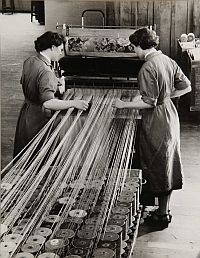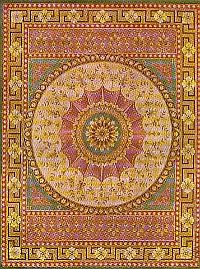Titanic carpet designs saved for the nation
Published: 28 January 2009
A unique archive of designs, patterns and carpets, including those made for the Titanic as well as the James Cameron film, has been preserved for historians and designers.
A unique archive of designs, patterns and carpets, including those that were made for the Titanic as well as the James Cameron film, has been preserved for the benefit of local and international historians and designers.
The design archive and heritage carpet collection of James Templeton & Co and Stoddard International, Scotland’s most successful carpet manufacturers, has been bought by the University of Glasgow in conjunction with Glasgow School of Art and Glasgow Museums with the assistance of a £172,000 grant from the National Heritage Memorial Fund. 
Stoddard and Templeton supplied carpet for a host of historic buildings and occasions such as Westminster Abbey; Windsor Castle; the Whitehouse, the Titanic; coronations since the mid-19th century and the parliament buildings of London, Canberra, Wellington and Cape Town.
This archive comprises 3,800 design drawings and patterns; 2,000 design sketches; a design library of 1,500 titles including books and journals; 226 carpet pieces and numerous albums of photographs, encapsulating the history of Scottish carpet manufacturing. It includes complete carpets displayed at major international exhibitions, such as the Twelve Apostles carpet made for the Paris Exhibition of 1867.
Clare Paterson, senior archivist at the University of Glasgow, said: “This collection is one of the biggest of its kind in the world. It demonstrates the design and technical achievements of James Templeton & Co. Ltd and Stoddard International plc which were both world leaders in carpet design and manufacture.
“The acquisition of the archive by the University, Glasgow School of Art and Glasgow Museums, will ensure the collection is preserved for the people of Scotland. Users of this rich archive will be able to explore the complete carpet-making process, from initial inspiration and drafting to the agreement of a pattern and colouring, through to final production and installation. We hope the collection will be a rich source of inspiration for Scotland’s future designers.”
The archive will also be a valuable resource for those seeking to restore post 18th-century historical interiors.
Carole Souter, Chief Executive of National Heritage Memorial Fund, said: "The National Heritage Memorial Fund is delighted to have been able to help save this unique archive for the nation. It is a fascinating and comprehensive record of interior decor throughout the last two centuries."
Over the next few years, the collection will be catalogued and made accessible with digital images available online alongside exhibitions and displays at Glasgow’s museums, the University and Glasgow School of Art.
Other organisations which contributed to the acquisition fund were the National Fund for Acquisitions (£20,000), Friends of the National Libraries (£7,000) and Friends of Glasgow Museums (£2,500). 
James Templeton & Co of Glasgow, whose iconic Bridgeton factory was modelled on the Doge’s Palace in Venice, was the largest manufacturer of quality carpets in the British Empire and was the largest employer in Glasgow in the 1950s, with around 7,000 workers. James Templeton led the way in technical innovation when he adopted the chenille principle in 1839, which paved the way for the introduction of power into the carpet-making process.
AF Stoddard & Son was founded by American Arthur Francis Stoddard in 1862 and within five years the firm was exporting 75 per cent of its products to the United States. The company took over a number of smaller carpet manufacturers in Scotland over the decades before being acquired by the Guthrie Corporation Ltd of London in 1980, of which Templeton’s was now part, creating Stoddard International plc.
Pamela Robertson, Senior Curator and Professor of Mackintosh Studies, Hunterian Art Gallery, said: “The acquisition of the Stoddard-Templeton collection is a major achievement. By working together, the University, Glasgow Museums and Glasgow School of Art have secured the future of a unique archive which records a key period in Scotland's design and manufacturing history.
“Templeton's and Stoddard were world leaders in carpet design and manufacture, matching the work of the UK's best designers with innovative production methods to create carpets which were in high demand across the world. These companies made Scotland a centre of excellence in the carpet industry.
“By retaining the collection as a whole, the three organisations have ensured that we, and future generations, can fully appreciate the outstanding achievements of Templeton's and Stoddard.”
The design archive and heritage carpet collection became available after Stoddard International went into liquidation in 2005.
Blair Nimmo, KPMG LLP, Liquidator of Stoddard International plc, said: “I am pleased that the National Heritage Memorial Fund has awarded funding to the University consortium to enable them to purchase the Archive. As the Archive will now remain intact, in Scotland, it will be accessible to the public as well as being available to inspire textile students and other designers in the future.”
Notes to editors
The National Heritage Memorial Fund (NHMF) is a fund of 'last resort', set up to save the nation's heritage in memory of those who gave their lives for this country. So far, NHMF has helped to save for the nation over 950 items. It currently receives £10million annual grant-in-aid from the government. For further information about the NHMF please contact Clare Makepeace or Alison Scott, NHMF Press Office, Tel: 020 7591 6143/6032, mobile: 07941 523 957 or email: clarem@hlf.org.uk.
National Fund for Acquisitions
Friends of the National Libraries
For more information, contact Stuart Forsyth in the University of Glasgow Media Relations Office on 0141 330 4831 or email s.forsyth@admin.gla.ac.uk
First published: 28 January 2009
<< January

